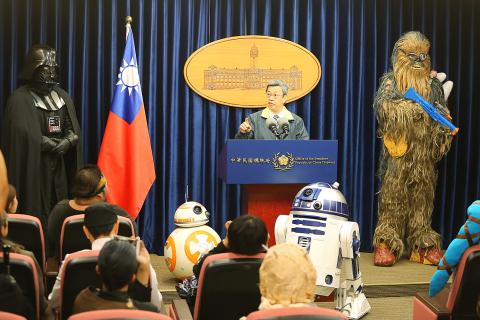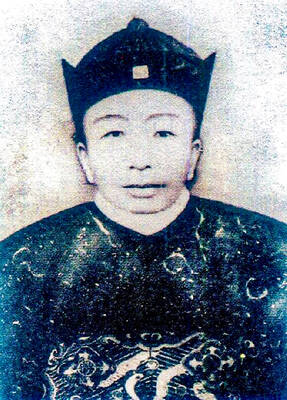To most people, May 4 is just another ordinary day on their calendar. But to diehard fans of the Star Wars series, the date is sacred.
May 4 was chosen by Star Wars fans as a worldwide holiday because “May the fourth” is a play on the movie series’ most iconic line — “May the force be with you.”
Star Wars fanatics celebrate the day with gatherings at which they dress up as the series’ popular characters, such as Darth Vader, Chewbacca and Princess Leia, and hold lightsabers, the main weapon in the Star Wars universe consisting of a metal hilt that projects a blade of plasma.

Taiwan is not immune from Star Wars fever, and this year Taiwanese fans made history by holding their annual gathering at the Presidential Office in downtown Taipei.
Over 100 Star Wars fans dressed as their favorite characters were welcomed by Vice President Chen Chien-jen (陳建仁), who called them “the first batch of visitors to the Presidential Office from outer space.”
The fans also held a ceremonial changing of the guard when the military police on duty switched posts with the Imperial Storm Troopers and rebellion forces soldiers.
The event was made possible by the efforts of Makoto Tsai (蔡榮洲), a diehard sci-fi aficionado and arguably Taiwan’s top Star Wars fan.
“It was like a dream come true for me. I just thought this is so surreal that I would wake up to find it was just a dream,” Tsai told CNA after successfully holding the Star Wars Day event.
Tsai said he had organized Star Wars Day celebrations at other public places such as the Chiang Kai-shek Memorial Hall and the 1914 Huashan Creative Park over the past four years, but was looking for a place that could best represent Taiwan.
“And the answer to me was the Presidential Office,” he said.
Star Wars characters had previously showed up at White House events before, he said, so why not Taiwan?
He was somewhat surprised to find that the Presidential Office was willing to accommodate his request and even allowed the group to bring lightsabers and laser guns to the building, which is normally off-limits to weapons-like toys for security reasons, Tsai said.
“I’m pretty sure this was one of the highest level Star Wars Day events anywhere in the world,” he gushed.
LIGHTSABER MASTER
Aside from being a leader of the Star Wars fan community, the 34-year-old is also a one-of-a-kind full-time lightsaber maker who sells his works to fans worldwide.
Lightsabers are the signature weapons used by the Jedi and the most recognizable gadget in the series. Thousands of people have devoted themselves to creating realistic representations of these fictional weapons, but Tsai’s works have stood out, earning him stardom on the Internet.
They’ve gained a devoted following because they are much brighter, lighter and easier to use than those sold on the official Star Wars Web site and even come with sound effects.
Tsai’s special talents can be traced back to his high school days when he first fell in love with the franchise.
His first encounter occurred in 2002 when he saw Star Wars: Episode II — Attack of the Clones while working part time at a movie theater and was dazzled by the film’s space battles and computer-generated special effects.
But what most caught his eye were the weapons used by the Jedi Knights and, desperate to have one himself, he bought a toy lightsaber from the series’ official site.
He discovered, however, that it was not as bright as those in the movie and broke easily when used in a pretend sword fight. So he decided to build one for himself using the handle of a broom.
It took six years of trial and error before perfecting his design, and he even changed his university path during the process and chose to major in optoelectronics in pursuit of his lightsaber dream.
After countless experiments, he found that LEDs were the best light source for a lightsaber.
His creations use a string of small LEDs that extend over the full length of the blade. The string is divided into several individually powered segments that can be turned on in sequence to create a scrolling effect similar to the lightsabers in the movies.
To make these weapons even more realistic, he installed a soundboard in the hilt of his lightsabers, giving the devices the motion sensor-controlled sound effects that simulate clashing and battle impact sounds.
Tsai originally built the lightsabers just for fun, but that changed when short clips of him and his friends playing with them appeared on YouTube.
The videos were an immediate hit, and people from around the world started to e-mail him hoping to buy one, starting a business that has become a full-time vocation.
His lightsabers are a little more expensive than those sold on the official Web site, but that has not dampened demand due to the high quality of his product and his ability to tailor the device to customer requests.
The lightsaber maker said it usually takes him one and a half days to make a laser blade and he now gets about a dozen orders a month, with 70 to 80 percent coming from the US and European countries.
LIFE-CHANGING EXPERIENCE
As a person who turned his favorite toy into a long-term career, Tsai said Star Wars has changed his life. Now, aside from building lightsabers, he also regularly organizes Star Wars fan meetings each month with cosplayers dressing like Star Wars characters. They also regularly visit hospitals for charity events to inspire kids with rare illnesses. Tsai admitted there is a challenge that could be daunting — finding a way next year to top the success of this year’s Star Wars Day at the Presidential Office.

The canonical shot of an East Asian city is a night skyline studded with towering apartment and office buildings, bright with neon and plastic signage, a landscape of energy and modernity. Another classic image is the same city seen from above, in which identical apartment towers march across the city, spilling out over nearby geography, like stylized soldiers colonizing new territory in a board game. Densely populated dynamic conurbations of money, technological innovation and convenience, it is hard to see the cities of East Asia as what they truly are: necropolises. Why is this? The East Asian development model, with

June 16 to June 22 The following flyer appeared on the streets of Hsinchu on June 12, 1895: “Taipei has already fallen to the Japanese barbarians, who have brought great misery to our land and people. We heard that the Japanese occupiers will tax our gardens, our houses, our bodies, and even our chickens, dogs, cows and pigs. They wear their hair wild, carve their teeth, tattoo their foreheads, wear strange clothes and speak a strange language. How can we be ruled by such people?” Posted by civilian militia leader Wu Tang-hsing (吳湯興), it was a call to arms to retake

This is a deeply unsettling period in Taiwan. Uncertainties are everywhere while everyone waits for a small army of other shoes to drop on nearly every front. During challenging times, interesting political changes can happen, yet all three major political parties are beset with scandals, strife and self-inflicted wounds. As the ruling party, the Democratic Progressive Party (DPP) is held accountable for not only the challenges to the party, but also the nation. Taiwan is geopolitically and economically under threat. Domestically, the administration is under siege by the opposition-controlled legislature and growing discontent with what opponents characterize as arrogant, autocratic

When Lisa, 20, laces into her ultra-high heels for her shift at a strip club in Ukraine’s Kharkiv, she knows that aside from dancing, she will have to comfort traumatized soldiers. Since Russia’s 2022 invasion, exhausted troops are the main clientele of the Flash Dancers club in the center of the northeastern city, just 20 kilometers from Russian forces. For some customers, it provides an “escape” from the war, said Valerya Zavatska — a 25-year-old law graduate who runs the club with her mother, an ex-dancer. But many are not there just for the show. They “want to talk about what hurts,” she